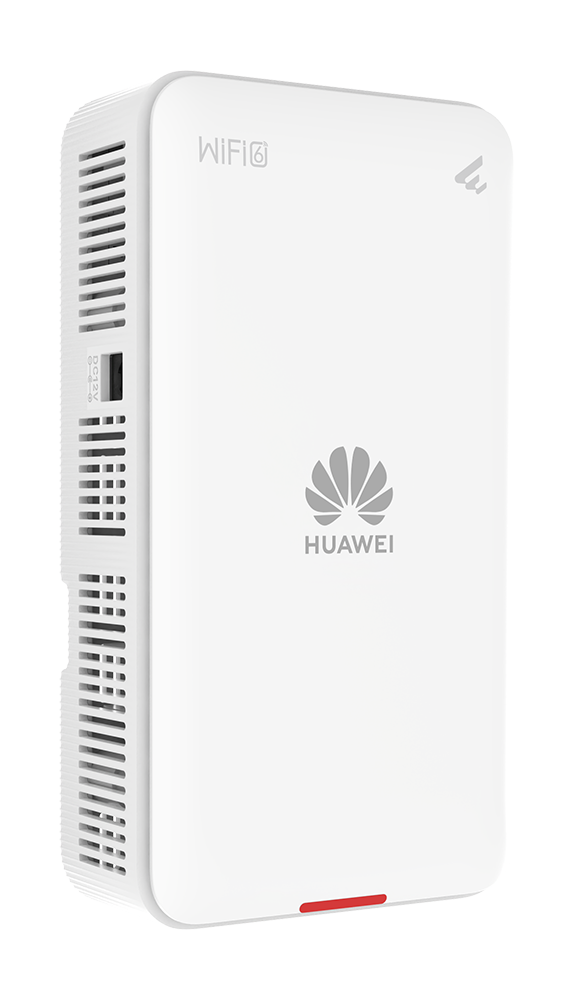-
zł

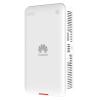
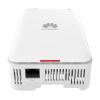
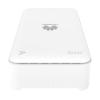


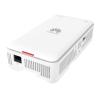
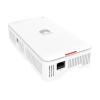
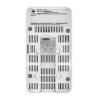
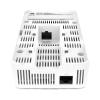
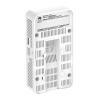
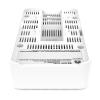
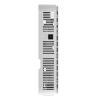

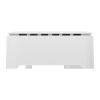
The Huawei AP263 is an access point from the eKitEngine series supporting the Wi-Fi 6 standard. It supports IEEE 802.11 b/g/n/ax protocols in the 2.4 GHz band and IEEE 802.11 a/n/ac/ax protocols in the 5 GHz band. The maximum theoretical throughput is 574 Mb/s in 2.4 GHz and 2402 Mb/s in 5 GHz. The device supports MU-MIMO (simultaneous data transmission and reception from multiple users), BSS coloring (transmission tagging to reduce interference), and TWT (Target Wake Time - a function allowing energy consumption reduction). The AP263 is designed for wall mounting, in the form of a socket. At the back, it has 1 gigabit Ethernet port, which also serves as a PoE power input in IEEE 802.3 af standard. In the lower part, there is a second gigabit port, which can be used to connect another device via cable. Power can also be supplied using the DC socket (input voltage is 12 V). The access point has a Smart antenna, consisting of multiple elements that can work independently. Depending on the needs, the antenna elements can modify the shape of the main beam and adapt to the connected clients.
The offered product can operate in several modes: Fat AP, Leader AP, Fit AP, or Cloud. In Fat AP mode, the device operates independently, and you can configure it like a regular wireless router. Leader AP mode allows you to configure the AP263 as a master device (leader) to manage other compatible access points. Cloud mode enables connecting the device to a controller located in the cloud, while Fit AP mode is used to connect with another physical WLAN AC controller. eKitEngine series solutions allow you to create an extensive and efficient wireless network that can cover very large areas. The devices support data roaming, bandwidth management, and multiple authentication methods. AP263 is perfect for office applications. It can simultaneously serve as an Ethernet socket and an access point.
Wi-Fi 6 AX3000 wireless network
The AP263 is designed to transmit Wi-Fi 6 wireless networks, supporting IEEE 802.11 b/g/n/ax protocols in the 2.4 GHz band and IEEE 802.11 a/n/ac/ax protocols in the 5 GHz band. The maximum theoretical throughput is 574 Mb/s in 2.4 GHz and 2402 Mb/s in 5 GHz. This speed is more than sufficient for most internet-related activities, including streaming 4K videos online, gaming, or downloading large files.
The access point also utilizes many additional features that positively impact network quality. MU-MIMO allows simultaneous transmission and reception of data from multiple clients, eliminating data queuing. Beamforming shapes the beam to improve connection with devices at the edge of the range, while TWT helps save energy by waking up connected devices only when transmission is initiated.


2 gigabit Ethernet ports, USB ports, PoE / DC socket plug
The offered product is equipped with 2 gigabit Ethernet ports (10/100/1000 Mb/s), one with PoE input located at the back of the enclosure, and the other at the bottom. You can power the device using PoE in 802.3 af standard or through the DC socket (12 V voltage). The maximum power consumption is 12 W. An additional asset is the USB port, which you can use to connect an external IoT device (ZigBee / RFID).
Smart antennas
The access point features Smart antennas, consisting of multiple elements that can work independently. Depending on the requirements, the antenna elements can modify the shape of the main beam to provide the best possible coverage to connected clients. The device adapts to radio conditions and provides significantly better signal coverage than APs equipped with standard omni-directional antennas. The gain is 2 dBi in the 2.4 GHz band and 3 dBi in the 5 GHz band.

Up to 256 clients
The Huawei AP263 can handle a maximum of 256 client devices connected simultaneously. APs from the eKitEngine series are well-suited for locations with or potentially hosting many users. The system supports load balancing and smart roaming, so if one access point becomes overloaded, users are switched to others.
The DFA (Dynamic Frequency Allocation) algorithm is used for automatically detecting wireless channel usage and recognizing overlapping transmissions. In the case of multiple access points, they operate to avoid interfering with each other. Additionally, technologies like EDCA (Enhanced Distributed Channel Access) and airtime scheduling enable the scheduling of channel utilization for specific client devices, ensuring equal access to the network for each of them.
A significant advantage of the eKitEngine-based system is the optimization of network utilization by client devices. Clients with low signal strength or slow connection speeds are automatically disconnected to improve overall transmission quality. Additionally, the AP263 features a 5G-prior function where client devices are primarily connected in the 5 GHz band to provide them with the best possible throughput. This reduces congestion and interference in the 2.4 GHz band significantly.
Advanced wireless system
The offered product is designed to work in a large wireless system composed of multiple access points. Such a network is capable of covering even very large areas, depending on the number of devices used. The system supports data roaming, where users are automatically switched between individual access points without losing their connection.
Huawei solutions offer a wide range of features related to bandwidth control, improving transmission quality, and security. For user authentication, you can utilize methods such as 802.1x, MAC addresses, or captive portal. An advanced management and monitoring system will help you reduce the time spent on network administration, for example, through automatic detection and recognition of various types of errors.


Four operating modes
Access points can operate in four modes:
- Fat AP - the access point operates independently, and configuring and managing it resembles the process for standard wireless routers. It's suitable for small networks where you use only one AP.
- Leader AP - it allows configuring the device as a "leader," thereby taking on the role of a controller in the network. You can connect other access points to the device in Leader AP mode to create an expanded system. This mode is best suited for small networks, such as offices or restaurants, and helps reduce costs associated with purchasing additional controllers.
- Cloud AP - in this mode, the access point can be managed from a cloud-based platform. This platform significantly simplifies monitoring work and conducting preliminary configurations, eliminating the need for additional management devices.
- Fit AP - this is the basic mode of operation in which the access point connects to a controller.
Multiple uses
The Huawei AP263 is ideally suited for office applications in various types of businesses due to its design. In addition to transmitting a wireless network, it provides users with an Ethernet port to which you can connect a device such as a PC. This helps reduce the amount of cabling used, especially if access to an Ethernet socket is necessary in a particular room.

Specifications
| Huawei AP263 | |
| Technical features | |
|---|---|
| Dimensions (H x W x D) |
160 mm x 86 mm x 38 mm |
| Weight | 0,32 kg |
| Interface type |
2 gigabit Ethernet ports (10/100/1000 Mb/s) 1 USB port |
| Bluetooth | BLE 5.0 |
| LED indicator | Indicates the power-on, startup, running, alarm, and fault states of the system |
| Power | |
| Power input | DC: 12 V ± 10% PoE power supply: in compliance with 802.3af |
| Maximum power consumption | 12 W (excluding USB) |
| Environmental | |
| Operating temperature | 0°C to 40°C |
| Storage temperature | -40°C to +70°C |
| Operating humidity | 5% to 95% (non-condensing) |
| Radio | |
| Antenna type | Built-in smart antennas |
| Antenna gain |
2,4 GHz: 2 dBi 5 GHz: 3 dBi |
| Maximum number of SSIDs for each radio | ≤ 16 |
| Maximum number of users | ≤ 256 |
| Maximum transmit power |
2,4 GHz: 23 dBm 5 GHz: 23 dBm (The actual transmit power depends on local laws and regulations) |
| Power increment | 1 dBm |
| Maximum number of non-overlapping channels |
2.4 GHz (2.412 GHz - 2.472 GHz) 802.11 b/g
802.11 n
802.11 ax
5 GHz (5.18 GHz - 5.825 GHz) 802.11 a
802.11 n
802.11 ac
802.11 ax
(The number of non-overlapping channels varies in different countries) |
| Fat/Fit AP mode | |
| WLAN features | Compliance with IEEE 802.11ax and compatibility with IEEE 802.11a/b/g/n/ac/ac Wave 2 Maximum ratio combining (MRC) Space time block code (STBC) Cyclic Delay Diversity (CDD)/Cyclic Shift Diversity (CSD) Beamforming Multi-user multiple-input multiple-output (MU-MIMO) Orthogonal frequency division multiple access (OFDMA) Compliance with 1024-quadrature amplitude modulation (QAM) and compatibility with 256-QAM, 64-QAM, 16-QAM, 8-QAM, quadrature phase shift keying (QPSK), and binary phase shift keying (BPSK) Target wake time (TWT) Low-density parity-check (LDPC) Frame aggregation, including A-MPDU (Tx/Rx) and A-MSDU (Tx/Rx) 802.11 dynamic frequency selection (DFS) Short guard interval (GI) in 20 MHz, 40 MHz, 80 MHz and 160 MHz modes Priority mapping and scheduling that are compliant with Wi-Fi multimedia (WMM) to implement priority-based data processing and forwarding Automatic and manual rate adjustment (the rate is adjusted automatically by default) WLAN channel management and channel rate adjustment Automatic channel scanning and interference avoidance Service set identifier (SSID) hiding Signal sustain technology (SST) Unscheduled automatic power save delivery (U-APSD) Control and Provisioning of Wireless Access Points (CAPWAP) in Fit AP mode Extended Service Set (ESS) in Fit AP mode Advanced cellular coexistence (ACC), minimizing the impact of interference from cellular networks Multi-user call admission control (CAC) 802.11k and 802.11v smart roaming 802.11r fast roaming (≤ 50 ms) |
| Network features | Compliance with IEEE 802.3ab Auto-negotiation of the rate and duplex mode and automatic switchover between the Media Dependent Interface (MDI) and Media Dependent Interface Crossover (MDI-X) Compliance with IEEE 802.1q SSID-based VLAN assignment VLAN trunk on uplink Ethernet ports Management channel of the AP uplink port in tagged and untagged mode DHCP client, obtaining IP addresses through DHCP Tunnel data forwarding and direct data forwarding STA isolation in the same VLAN IPv4/IPv6 access control lists (ACLs) Link Layer Discovery Protocol (LLDP) Uninterrupted service forwarding upon CAPWAP channel disconnection in Fit AP mode Unified authentication on the AC in Fit AP mode AC dual-link backup in Fit AP mode Network Address Translation (NAT) in Fat AP mode IPv6 in Fit AP mode Telemetry in Fit AP mode, quickly collecting AP status and application experience parameters IPv6 Source Address Validation Improvements (SAVI) Multicast Domain Name Service (mDNS) gateway protocol |
| QoS features | Priority mapping and scheduling that are compliant with WMM to implement priority-based data processing and forwarding WMM parameter management for each radio WMM power saving Priority mapping for upstream packets and flow-based mapping for downstream packets Queue mapping and scheduling User-based bandwidth limiting Adaptive bandwidth management (automatic bandwidth adjustment based on the user quantity and radio environment) to improve user experience Airtime scheduling Air interface HQoS scheduling Intelligent multimedia scheduling |
| Security features |
Open system authentication |
| Maintenance features | Unified management and maintenance on the AC in Fit AP mode Automatic login and configuration loading, and plug-and-play (PnP) in Fit AP mode Batch upgrade in Fit AP mode Telnet STelnet using SSHv2 SFTP using SSHv2 Remote wireless O&M through the Bluetooth serial interface Web-based local AP management through HTTP or HTTPS in Fat AP mode Real-time configuration monitoring and fast fault locating using the NMS SNMP v1/v2/v3 in Fat AP mode System status alarm Network Time Protocol (NTP) in Fat AP mode |
| Location service |
Wi-Fi terminal location (The AP supports the locating service only in Fit or cloud AP mode) |
| Cloud mode | |
| WLAN features | Compliance with IEEE 802.11ax and compatibility with IEEE 802.11a/b/g/n/ac/ac Wave 2 Maximum ratio combining (MRC) Space time block code (STBC) Cyclic Delay Diversity (CDD)/Cyclic Shift Diversity (CSD) Beamforming Multi-user multiple-input multiple-output (MU-MIMO) Orthogonal frequency division multiple access (OFDMA) Compliance with 1024-quadrature amplitude modulation (QAM) and compatibility with 256-QAM, 64-QAM, 16-QAM, 8-QAM, quadrature phase shift keying (QPSK), and binary phase shift keying (BPSK) Target wake time (TWT) Low-density parity-check (LDPC) Frame aggregation, including A-MPDU (Tx/Rx) and A-MSDU (Tx/Rx) 802.11 dynamic frequency selection (DFS) Priority mapping and scheduling that are compliant with Wi-Fi multimedia (WMM) to implement priority-based data processing and forwarding Automatic and manual rate adjustment (the rate is adjusted automatically by default) WLAN channel management and channel rate adjustment Automatic channel scanning and interference avoidance Service set identifier (SSID) hiding Signal sustain technology (SST) Unscheduled automatic power save delivery (U-APSD) |
| Network features | Compliance with IEEE 802.3ab Auto-negotiation of the rate and duplex mode and automatic switchover between the Media Dependent Interface (MDI) and Media Dependent Interface Crossover (MDI-X) Compliance with IEEE 802.1q SSID-based VLAN assignment DHCP client, obtaining IP addresses through DHCP STA isolation in the same VLAN Access control lists (ACLs) Unified authentication on the Cloud management platform Network Address Translation (NAT) |
| QoS features |
Priority mapping and scheduling that are compliant with WMM to implement priority-based data processing and forwarding |
| Security features | Open system authentication WEP authentication/encryption using a 64-bit, 128-bit, 152-bit or 192-bit encryption key WPA2-PSK authentication and encryption (WPA2-Personal) WPA2-802.1X authentication and encryption (WPA2-Enterprise) WPA3-SAE authentication and encryption (WPA3-Personal) WPA3-802.1X authentication and encryption (WPA3-Enterprise) WPA-WPA2 hybrid authentication WPA2-WPA3 hybrid authentication 802.1X authentication, MAC address authentication, and Portal authentication DHCP snooping Dynamic ARP Inspection (DAI) IP Source Guard (IPSG) |
| Maintenance features | Unified management and maintenance on the Cloud management platform Automatic login and configuration loading, and plug-and-play (PnP) Batch upgrade Telnet STelnet using SSHv2 SFTP using SSHv2 Remote wireless O&M through the Bluetooth console port Web-based local AP management through HTTP or HTTPS Real-time configuration monitoring and fast fault locating using the NMS System status alarm Network Time Protocol (NTP) |






 Polski
Polski English
English Italiano
Italiano Español
Español Čeština
Čeština Српски
Српски Deutsch
Deutsch Ελληνικά
Ελληνικά Slovenský
Slovenský

